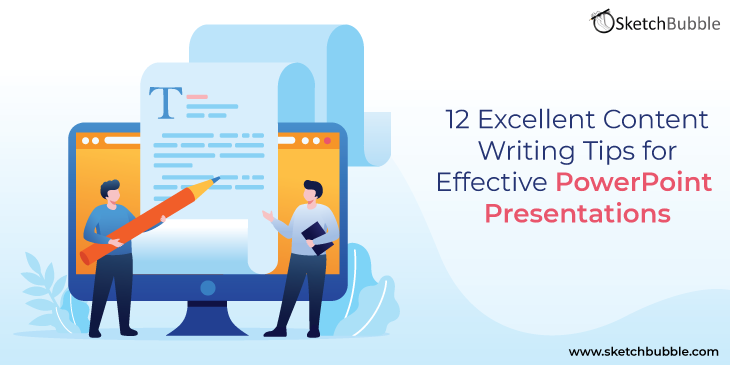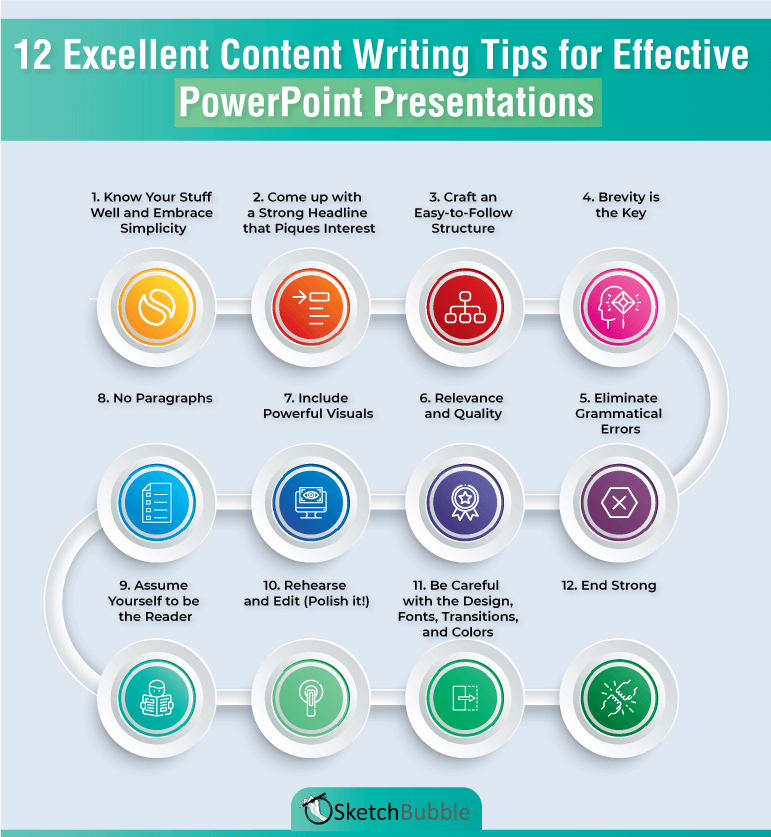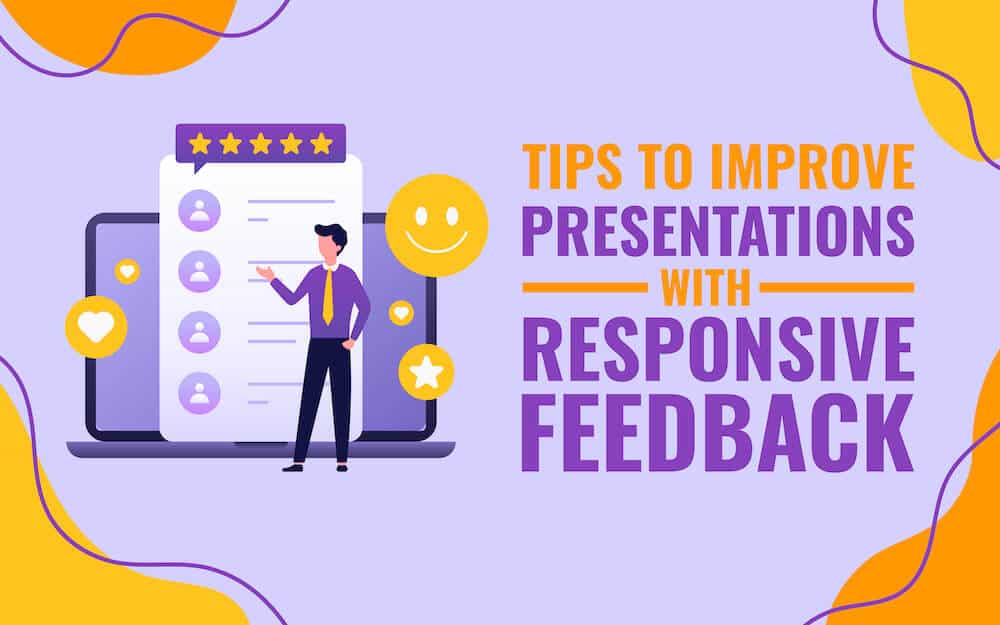
If you’re in business or a job, the odds are great that you’ll be creating a PowerPoint slideshow at some point in time. Unfortunately, even if your spoken presentation is well rehearsed, a poor visual experience can ruin it for your audience. So, there’s a real need to create persuasive and engaging presentations rather than just throwing a bunch of slides together. However, writing a presentation is daunting for many. Creating a superior script takes time to master, and we completely get it!
So here are some of our best tips and tricks that will help you craft excellent quality content and connect with your audience.
1. Know Your Stuff Well and Embrace Simplicity
A presentation is not just about the slides alone but the message that you want to convey. So, it becomes significant to give due consideration to the narrative that’ll be discussed.
Also, you must go for a simple theme that keeps the listeners focused on what you are conveying. A good rule of thumb is less is more; present only one idea on each slide and limit the number of transitions, which could distract the viewers rather than enhance the impact of the presentation.
Pro Tip: Eliminate mental and visual clutter so that you can give your slides room to breathe and your audience a chance to connect with you effortlessly.
2. Come up with a Strong Headline that Piques Interest
A title is the first exposure to your slideshow and sets the expectation and tone of your presentation. Therefore, putting more thought into your presentation title is as important as having a proper structure or a strong call to action. A headline not just identifies the subject matter but creates expectations for the members of the audience. So, invest enough time to come up with an exciting title that piques the interest of your viewers and makes them want to know more. checkout 91 Awesome Headline Formulas To Make Your Presentations Instantly Attractive
3. Craft an Easy-to-Follow Structure
When it comes to what you have to speak during the presentation, you need to break it down into three sections: an introduction, a body, and a conclusion. You should briefly sum up what you will discuss with a compelling introduction so that the listeners can quickly make a mental picture. Then, hit them with quotes, facts, statistics, and evidence to appropriately back up your major points for the main message. Finally, sum up by giving your audience some key takeaways that could help them put into practice what they learned so far.
4. Brevity is the Key
Keeping a presentation short and to the point is one of the most important things to remember. Overloading the slides with chunks of information can confuse the audience. By keeping just ten slides in your deck, even if your presentation is long, you’ll allow the audience to digest your on-screen message with ease. In addition, the most striking PPTs have fewer (a good rule of thumb is less than forty words per slide) words on every slide. So, shorten your bullets and just highlight what is essential rather than sharing the idea in its entirety. You can also think about narrating a story to compel your audience to listen and get your message across.
Pro Tip: Pick the key points to present and provide the rest of the stuff in an “Appendix” to be referred to during the Q&A session to be held towards the end.
5. Eliminate Grammatical Errors
Subpar text, riddled with grammatical errors, will easily ruin your entire presentation. The effectiveness of the presentation depends not just upon how you present your thoughts and ideas but on the content as well. Incorrect placement of punctuation, grammatical errors in the sentences, incorrect capitalization, and mixing of homophones will dilute the message you want to convey and create a wrong impression with your audience.
Pro Tip: To make your content error-free, download the Grammarly app as well as its browser extension.
6. Relevance and quality
Relevance and quality are the keys to a terrific presentation. For this, keep the sentence structure simple and the flow of the presentation smooth so that the viewers can draw relevant conclusions. To make the content more relevant and keep your audience engaged pretty well, use the ‘hooks.’ These might be in the form of questions for audience participation, stories, a shocking fact, or any other visual aids, such as a short video.
7. Include Powerful Visuals
One of the most subtle ways to include visuals in your slides is by using infographics. An infographic is a perfect tool for visual communication that lets you bring your presentation to life quickly. For example, you can use donut graphs in PowerPoint to make comparisons and harness their power to create an impact. Visuals not just jazz up the slides but reinforce the message too. Checkout Impact of Visual Aids in Presentations Finally, make sure to use high-resolution images to support your content and make it appear more professional.
8. No Paragraphs
If you want to craft a winning presentation, make sure that you don’t let your text dominate the space on the slides. Chunky blocks of text can easily lead to boredom and eventually kill the very essence of a presentation. On the other hand, too much clutter can be overwhelming, and to avoid it, prioritize simplicity. For example, to get rid of the text-heavy paragraphs, you can split the entire content into aligned columns and accompany them with a relevant icon to amp up the overall style quotient of the deck.
9. Assume Yourself to be the Reader
Before you decide to craft the script and place your fingers on your keyboard, ensure that you understand your readers. To get the best results, assume you’re the reader, as this will help you write it from their standpoint. For example, avoiding technical jargon and interruptions could eliminate potential confusion and difficulty in understanding for the audience. Write your points in a manner that magnifies the meaning and persuades the viewers to stick with you throughout the presentation.
10. Rehearse and Edit (Polish it!)
Don’t forget to rehearse the script verbally and edit it after that. To be more confident about the overall content of the presentation, you can even ask a trusted colleague or friend to review the script for embarrassing typos and anything that could undermine the message. Then, to make sure your ideas come through loud and clear and your information is easier to digest, polish several times. At first, it may appear messy with a tremendous amount of data but keep editing ruthlessly until you trim down your message to the bare essentials.
11. Be Careful with the Design, Fonts, Transitions, and Colors
A professionally designed PowerPoint template cannot alone do the job. In addition, you need to be careful with your choice of fonts and colors. Choosing an outdated color can instantly render your presentation ineffective, and including unconventional fonts can make you appear unprofessional. So, as tempting as it may seem to use fancy fonts, use standard, time-tested fonts and stick with a simple, minimalist design for maximum impact. In addition, PowerPoint offers diverse transitions, but experimenting with them too much can do more harm than good. So, minimize the variety of transitions in your presentation and opt for a simple ‘fade’ effect!
12. End Strong
End your presentation with a clear call to action. For that, choose a statement that is persuasive, upbeat, and actionable. Keep the focus on the feeling that you want your audience to take back home. Consider pausing for the key takeaways and strike a chord to end on a high.

Final Thoughts
Remember, a flowing conveyance of facts, ideas, and information entirely depends on the content’s appropriateness in the PPT. An innovative and interactive presentation helps you hit the bull’s eye instantly. However, an interactive PowerPoint presentation doesn’t mean excessive usage of flash images and graphics; it also includes writing the correct content in the proper flow and style. The apt and relevant content will help your presentations shine like a beacon in a sea of words. So, use the guidelines above, and we’re sure; you will soon be able to add real value to your presentations with a distinct style and voice.
Do you have any content writing tips of your own? Share them in the comments below. And if you like the blog post, don’t forget to share it on your social media handles.



